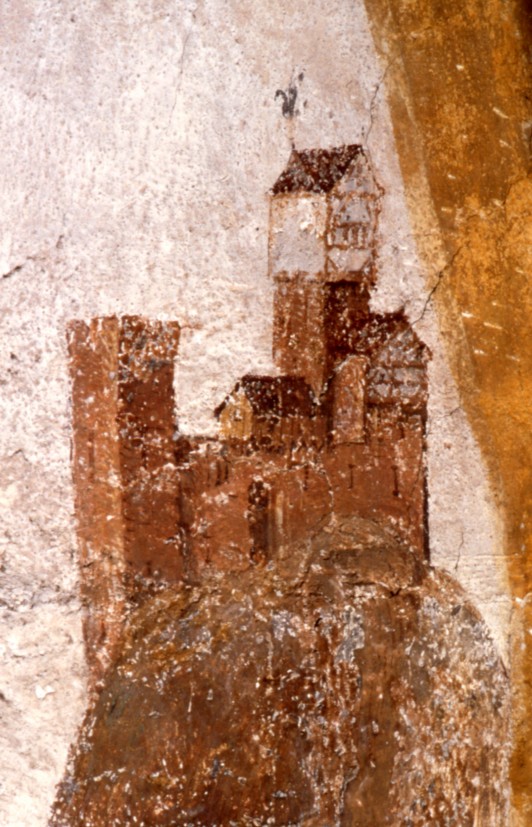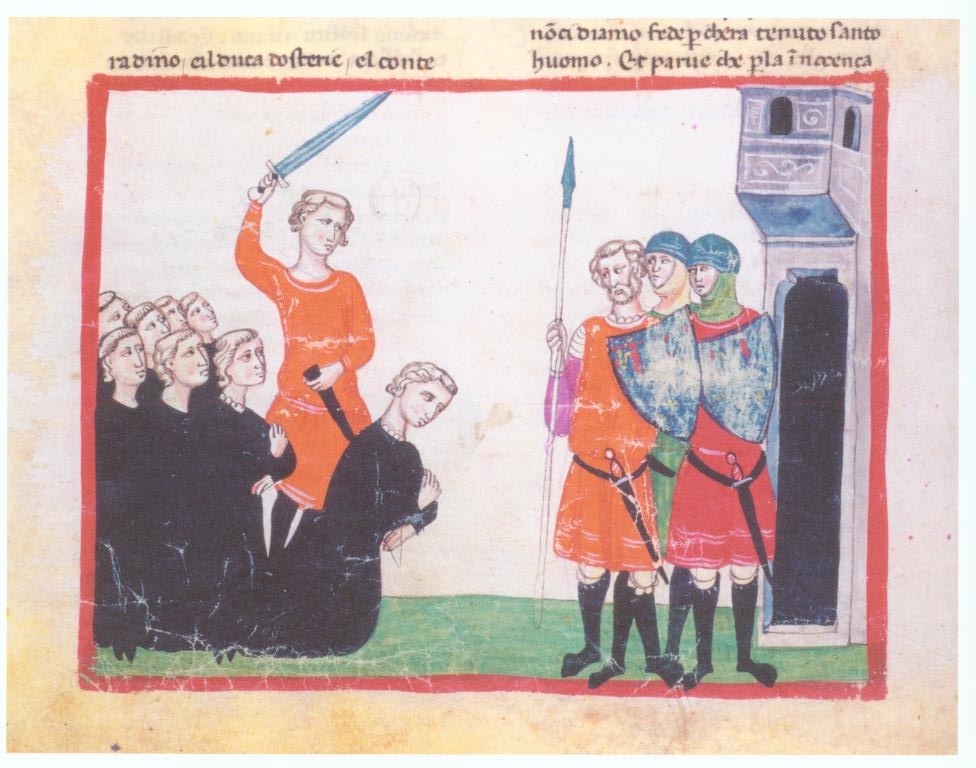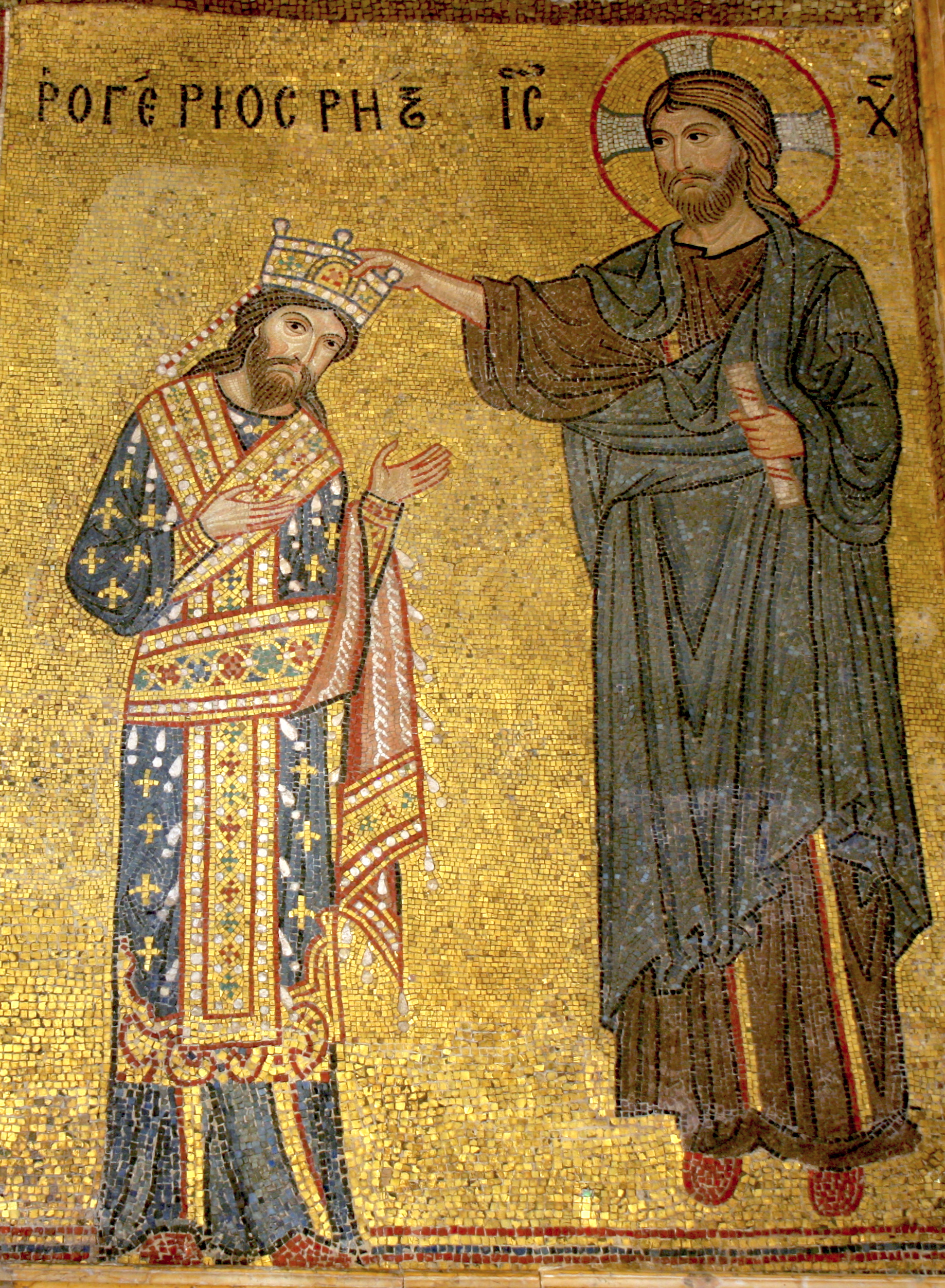|
Hohenstaufen
The Hohenstaufen dynasty (, , ), also known as the Staufer, was a noble family of unclear origin that rose to rule the Duchy of Swabia from 1079, and to royal rule in the Holy Roman Empire during the Middle Ages from 1138 until 1254. The dynasty's most prominent rulers – Frederick I (1155), Henry VI (1191) and Frederick II (1220) – ascended the imperial throne and also reigned over Italy and Burgundy. The non-contemporary name of 'Hohenstaufen' is derived from the family's Hohenstaufen Castle on Hohenstaufen mountain at the northern fringes of the Swabian Jura, near the town of Göppingen. Under Hohenstaufen rule, the Holy Roman Empire reached its greatest territorial extent from 1155 to 1268. Name The name Hohenstaufen was first used in the 14th century to distinguish the 'high' (''hohen'') conical hill named Staufen in the Swabian Jura (in the district of Göppingen) from the village of the same name in the valley below. The new name was applied to the hill c ... [...More Info...] [...Related Items...] OR: [Wikipedia] [Google] [Baidu] |
Frederick II, Holy Roman Emperor
Frederick II (, , , ; 26 December 1194 – 13 December 1250) was King of Sicily from 1198, King of Germany from 1212, King of Italy and Holy Roman Emperor from 1220 and King of Jerusalem from 1225. He was the son of Emperor Henry VI, Holy Roman Emperor, Henry VI of the Hohenstaufen dynasty (the second son of Emperor Frederick Barbarossa) and Queen Constance I of Sicily of the Hauteville dynasty. Frederick was one of the most powerful figures of the Middle Ages and ruled a vast area, beginning with Sicily and stretching through Italy all the way north to Germany. Viewing himself as a direct successor to the Roman emperors of antiquity, he was Holy Roman Emperor, Emperor of the Romans from his papal coronation in 1220 until his death; he was also a claimant to the title of King of the Romans from 1212 and unopposed holder of that monarchy from 1215. As such, he was King of Germany, King of Italy, of Italy, and King of Burgundy, of Burgundy. At the age of three, he was crowned King ... [...More Info...] [...Related Items...] OR: [Wikipedia] [Google] [Baidu] |
Hohenstaufen Castle
Hohenstaufen Castle () is a ruined castle in Göppingen in Baden-Württemberg, Germany. The hill castle was built in the 11th century, on a conical hill between the Rems and Fils rivers (both tributaries of the Neckar) in what was then the Duchy of Swabia. It was the seat of the Staufer (Hohenstaufen) dynasty, the Dukes of Swabia for the period of 1079–1268, with three Holy Roman Emperors during 1155–1250. The castle was destroyed in the German Peasants' War of 1525.https://www.marxists.org/archive/marx/works/1850/peasant-war-germany/ch05.htm Hohenstaufen Castle can be found on Hohenstaufen Mountain, 684 m (2,244 ft) above sea level. The word ''Stauf'' means "drinking vessel" ( beaker or cup) and refers to the conical shape of the mountain. Middle Ages Hohenstaufen castle was built about 1070 by Frederick I of Hohenstaufen—even before he became Duke of Swabia—as a fortress to protect family interests in the vicinity. Until the 13th century, the castle wa ... [...More Info...] [...Related Items...] OR: [Wikipedia] [Google] [Baidu] |
Henry VI, Holy Roman Emperor
Henry VI (German language, German: ''Heinrich VI.''; November 1165 – 28 September 1197), a member of the Hohenstaufen dynasty, was King of Germany (King of the Romans) from 1169 and Holy Roman Emperor from 1191 until his death. From 1194 he was also King of Sicily as the husband and co-ruler of Queen Constance I. Henry was the second son of Emperor Frederick Barbarossa and Beatrice I, Countess of Burgundy. Well educated in the Latin language, as well as Roman law, Roman and canon law, Henry was also a patron of poets and a skilled poet himself. In 1186 he married Constance of Sicily. Henry, stuck in the Hohenstaufen conflict with the House of Welf until 1194, had to enforce the inheritance claims by his wife against her nephew Count Tancred of Lecce. Henry's attempt to conquer the Kingdom of Sicily failed at the Siege of Naples (1191), siege of Naples in 1191 due to an epidemic, with Empress Constance captured. Based on an enormous ransom for the release and submission of King R ... [...More Info...] [...Related Items...] OR: [Wikipedia] [Google] [Baidu] |
Holy Roman Empire
The Holy Roman Empire, also known as the Holy Roman Empire of the German Nation after 1512, was a polity in Central and Western Europe, usually headed by the Holy Roman Emperor. It developed in the Early Middle Ages, and lasted for a millennium until its Dissolution of the Holy Roman Empire, dissolution in 1806 during the Napoleonic Wars. For most of its history the Empire comprised the entirety of the modern countries of Germany, Czechia, Austria, the Netherlands, Belgium, Switzerland, Slovenia, and Luxembourg, most of north-central Italy, and large parts of modern-day east France and west Poland. On 25 December 800, Pope Leo III crowned the Frankish king Charlemagne Roman emperor, reviving the title more than three centuries after the fall of the Western Roman Empire in 476. The title lapsed in 924, but was revived in 962 when Otto I, OttoI was crowned emperor by Pope John XII, as Charlemagne's and the Carolingian Empire's successor. From 962 until the 12th century, the empire ... [...More Info...] [...Related Items...] OR: [Wikipedia] [Google] [Baidu] |
Conradin
Conrad III (25 March 1252 – 29 October 1268), called ''the Younger'' or ''the Boy'', but usually known by the diminutive Conradin (, ), was the last direct heir of the House of Hohenstaufen. He was Duke of Swabia (1254–1268) and nominal King of Jerusalem (1254–1268) and King of Sicily, Sicily (1254–1258). After Battle of Tagliacozzo, his attempt to reclaim the Kingdom of Sicily for the Hohenstaufen dynasty failed, he was captured and beheaded. Early childhood Conradin was born in Landshut, Wolfstein, Bavaria, to Conrad IV of Germany and Elisabeth of Bavaria, Queen of Germany, Elisabeth of Bavaria. Though he never succeeded his father as King of the Romans, Roman-German king, he was recognized as king of Sicily and Jerusalem by supporters of the Hohenstaufens in 1254. Having lost his father in 1254, he grew up at the court of his uncle and guardian, Louis II, Duke of Bavaria. His guardians were able to hold Swabia for him. Jerusalem was held by a relative from the royal h ... [...More Info...] [...Related Items...] OR: [Wikipedia] [Google] [Baidu] |
Kingdom Of Sicily
The Kingdom of Sicily (; ; ) was a state that existed in Sicily and the southern Italian peninsula, Italian Peninsula as well as, for a time, in Kingdom of Africa, Northern Africa, from its founding by Roger II of Sicily in 1130 until 1816. It was a successor state of the County of Sicily, which had been founded in 1071 during the Norman conquest of southern Italy, Norman conquest of the southern peninsula. The island was divided into Three valli of Sicily, three regions: Val di Mazara, Val Demone and Val di Noto. After a brief rule by Charles of Anjou, a revolt in 1282 known as the Sicilian Vespers threw off Capetian House of Anjou, Angevin rule in the island of Sicily. The Angevins managed to maintain control in the mainland part of the kingdom, which became a separate entity also styled ''Kingdom of Sicily'', although it is retroactively referred to as the Kingdom of Naples. Sicily (officially known as the Kingdom of Trinacria between 1282 and 1442) at the other hand, remained a ... [...More Info...] [...Related Items...] OR: [Wikipedia] [Google] [Baidu] |
Frederick I, Holy Roman Emperor
Frederick Barbarossa (December 1122 – 10 June 1190), also known as Frederick I (; ), was the Holy Roman Emperor from 1155 until his death in 1190. He was elected King of Germany in Frankfurt am Main, Frankfurt on 4 March 1152 and crowned in Aachen on 9 March 1152. He was crowned King of Italy on 24 April 1155 in Pavia and emperor by Pope Adrian IV on 18 June 1155 in Rome. Two years later, the term ' ("holy") first appeared in a document in connection with his empire. He was later formally crowned King of Burgundy, at Arles on 30 June 1178. His nickname of ' (meaning "Red Beard" in Italian) "was first used by the Republic of Florence, Florentines only in 1298 to differentiate the emperor from his grandson, Frederick II, Holy Roman Emperor, Frederick II ... and was never employed in medieval Germany" (the colour red was "also associated in the Middle Ages with malice and a hot temper"; in reality, Frederick's hair was "blond", although his beard was described by a contemporar ... [...More Info...] [...Related Items...] OR: [Wikipedia] [Google] [Baidu] |
Henry (VII) Of Germany
Henry (VII) (1211 – 12 February 1242), a member of the Hohenstaufen dynasty, was King of Sicily from 1212 until 1217 and King of Germany (formally '' Rex Romanorum'') from 1222 until 1235, as son and king, co-ruler of Emperor Frederick II. He was the seventh Henry to rule Germany, but in order to avoid confusion with the Luxembourg emperor Henry VII, he is usually numbered Henry (VII). Under custody Henry was born in Sicily, the only son of King Frederick II and his first wife, Constance of Aragon.Steven Runciman, ''The Sicilian Vespers'', (Cambridge University Press, 2000), 26. He was the elder brother of Conrad IV, who eventually succeeded him as king. While Frederick sought to be elected German king against his Welf rival Otto IV, he had his new-born son crowned King of Sicily (as Henry II) by Pope Innocent III in March 1212, since an agreement between Frederick and the Pope stated that the kingdoms of Germany and Sicily should not be united under one ruler. For this, t ... [...More Info...] [...Related Items...] OR: [Wikipedia] [Google] [Baidu] |
Duchy Of Swabia
The Duchy of Swabia (; ) was one of the five stem duchy, stem duchies of the medieval Kingdom of Germany, German Kingdom. It arose in the 10th century in the southwestern area that had been settled by Alemanni tribes in Late Antiquity. While the historic region of Swabia takes its name from the ancient Suebi, dwelling in the angle formed by the Rhine and the Danube, the stem duchy comprised a much larger territory, stretching from the Alsatian Vosges mountain range in the west to the right bank of the river Lech (river), Lech in the east and up to Chiavenna (''Kleven'') and Gotthard Pass in the south. The name of the larger stem duchy was often used interchangeably with ''Alamannia'' during the High Middle Ages, until about the 11th century, when the form Swabia began to prevail. The Duchy of Swabia was proclaimed by the Ahalolfings, Ahalolfing count palatine Erchanger, Duke of Swabia, Erchanger in 915. He had allied himself with his Hunfridings, Hunfriding rival Burchard II, Du ... [...More Info...] [...Related Items...] OR: [Wikipedia] [Google] [Baidu] |
Duke Of Swabia
The Dukes of Swabia were the rulers of the Duchy of Swabia during the Middle Ages. Swabia was one of the five stem duchy, stem duchies of the medieval German kingdom, and its dukes were thus among the most powerful magnates of Germany. The most notable family to rule Swabia was the Hohenstaufen family, who held it, with a brief interruption, from 1079 until 1268. For much of that period, the Hohenstaufen were also Holy Roman Emperors. With the death of Conradin, the last Duke of Hohenstaufen, the duchy itself disintegrated although King Rudolph I of Germany, Rudolf I attempted to revive it for his Habsburg family in the late 13th century. Dukes of Swabia (909–1268) Early dukes * Burchard I Hunfriding (d. 911), mentioned as ''marchio'' (margrave) in 903 and ''dux'' (duke) in 909 * Erchanger, Duke of Swabia, Erchanger Ahalolfing, dominant count in Alemannia after the execution of Burchard I, declared duke in 915, exiled September 916, executed January 917. * Burchard II, Duke of ... [...More Info...] [...Related Items...] OR: [Wikipedia] [Google] [Baidu] |
King Of Sicily
The monarchs of Sicily ruled from the establishment of the Kingdom of Sicily in 1130 until the "perfect fusion" in the Kingdom of the Two Sicilies in 1816. The origins of the Sicilian monarchy lie in the Norman conquest of southern Italy which occurred between the 11th and 12th century. Sicily, which was ruled as an Islamic Emirate of Sicily, emirate for at least two centuries, was invaded in 1071 by Normans, Norman House of Hauteville, who conquered Palermo and established a feudal county named the County of Sicily. The House of Hauteville completed their conquest of Sicily in 1091. In 1130, the County of Sicily and the County of Apulia, ruled by different branches of the House of Hauteville, merged as the Kingdom of Sicily, and Count Roger II of Sicily, Roger II was crowned king by Antipope Anacletus II. In 1282, after the Sicilian Vespers, the kingdom split into separate states: the properly named "Ultra Sicily" (''Siciliae ultra Pharum'', Latin for "Sicily over the Strait of M ... [...More Info...] [...Related Items...] OR: [Wikipedia] [Google] [Baidu] |
Kingdom Of Italy (Holy Roman Empire)
The Kingdom of Italy ( or ; ; ), also called Imperial Italy (; ), was one of the constituent kingdoms of the Holy Roman Empire, along with the kingdoms of Germany, Bohemia, and Burgundy. It originally comprised large parts of northern and central Italy. Its original capital was Pavia until the 11th century. Following the fall of the Western Roman Empire in 476 and the brief rule of Odoacer, Italy was ruled by the Ostrogoths and later the Lombards. In 773, Charlemagne, the king of the Franks, crossed the Alps and invaded the Lombard kingdom, which encompassed all of Italy except the Duchy of Rome, the Republic of Venice and the Byzantine possessions in the south. In June 774, the kingdom collapsed and the Franks became masters of northern Italy. The southern areas remained under Lombard control, as the Duchy of Benevento was changed into the independent Principality of Benevento. Charlemagne called himself king of the Lombards and in 800 was crowned emperor in Rome. Membe ... [...More Info...] [...Related Items...] OR: [Wikipedia] [Google] [Baidu] |







